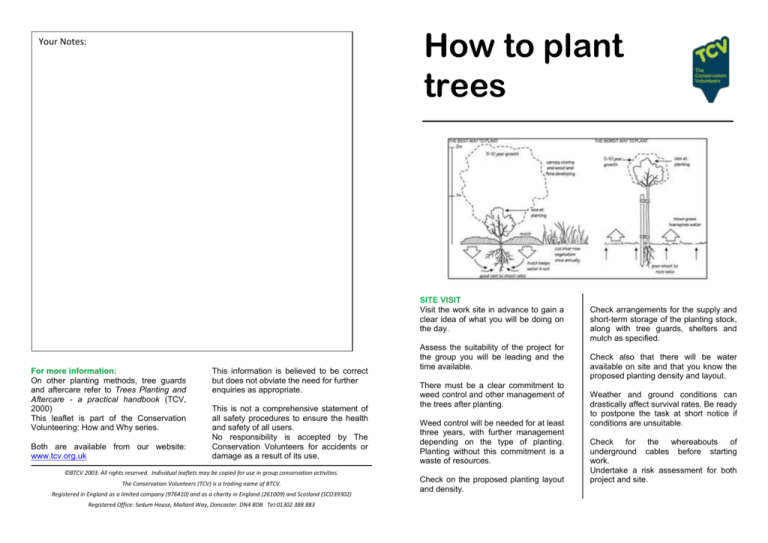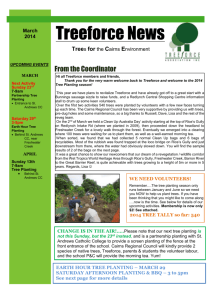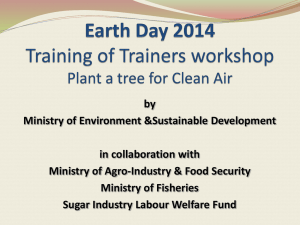
How to plant
trees
Your Notes:
SITE VISIT
Visit the work site in advance to gain a
clear idea of what you will be doing on
the day.
For more information:
On other planting methods, tree guards
and aftercare refer to Trees Planting and
Aftercare - a practical handbook (TCV,
2000)
This leaflet is part of the Conservation
Volunteering: How and Why series.
Both are available from our website:
www.tcv.org.uk
This information is believed to be correct
but does not obviate the need for further
enquiries as appropriate.
This is not a comprehensive statement of
all safety procedures to ensure the health
and safety of all users.
No responsibility is accepted by The
Conservation Volunteers for accidents or
damage as a result of its use.
©BTCV 2003. All rights reserved. Individual leaflets may be copied for use in group conservation activities.
The Conservation Volunteers (TCV) is a trading name of BTCV.
Registered in England as a limited company (976410) and as a charity in England (261009) and Scotland (SCO39302)
Registered Office: Sedum House, Mallard Way, Doncaster. DN4 8DB Tel:01302 388 883
Assess the suitability of the project for
the group you will be leading and the
time available.
There must be a clear commitment to
weed control and other management of
the trees after planting.
Weed control will be needed for at least
three years, with further management
depending on the type of planting.
Planting without this commitment is a
waste of resources.
Check on the proposed planting layout
and density.
Check arrangements for the supply and
short-term storage of the planting stock,
along with tree guards, shelters and
mulch as specified.
Check also that there will be water
available on site and that you know the
proposed planting density and layout.
Weather and ground conditions can
drastically affect survival rates. Be ready
to postpone the task at short notice if
conditions are unsuitable.
Check for the whereabouts of
underground cables before starting
work.
Undertake a risk assessment for both
project and site.
INTRODUCTION
Introduce the site, the work and the
reasons for doing it.
Walk around the site explaining what work
will be undertaken.
Identify potential hazards and explain how
to work safely around them.
Demonstrate Tool Use
Demonstrate and explain the safe use,
carrying and on-site care of the tools
before starting work.
Refer to the BTCV Hand Tools booklet.
Demonstrate Work Techniques
Demonstrate all new work techniques as
you come to them. This will save mistakes
and avoid accidents. The first tree should
be planted so everyone knows what they
should be doing.
Keep the fine fibrous roots moist and out
of the wind at all times.
Trim any damaged roots or shoots.
While trees are on site they should be
heeled in or covered in wet sacking and
moistened regularly. Alternatively, use tree
bags with a black inner and white outer.
Organisation of team
Divide the team into pairs, teaming
beginners with more experienced people.
The most efficient way to work is to form a
production line, each team doing a
specific job, e.g. digging holes, hammering
in the stakes, planting the trees and
attaching the shelters/guards. Swap pairs
around at tea or lunch breaks.
When planting a mixture, plant clumps of
each species to minimise the possibility of
one species out-competing another,
unless otherwise indicated by the site
plan.
Pit Planting and Staking
For large trees, over 1.5m, including
fruit trees and specimen trees.
A short stake with a single tie is the best
method. Aim to anchor the root ball in
the ground while leaving enough stem
free to sway.
Plant trees upright and to the same depth
as they were previously growing - use the
root collar or soil mark on the stem.
Tread the soil firm after planting and check
the tree to ensure it is firm and upright.
The leader should check, assist and
encourage people and ensure work
standards are maintained.
Notch Planting
The quickest method for trees up to 45cm.
Plan the delivery of materials to minimise
distances carried. Provide aids e.g.
wheelbarrow to avoid manual handling.
Demonstrate the correct lifting technique
(bending the knee and keeping the back
straight so that the leg muscles are used
and the back is not strained).
Refer to the BTCV Basic Safety leaflet.
Weeding
Cut a notch with a spade or mattock and,
whilst holding it open, slip the tree in and
spread the roots.
Make sure the root collar is level with the
soil surface.
Then tread the split closed and check that
the tree is firmly planted.
This can be done in pairs, one cutting the
slit and holding it open while the other
plants the tree.
Each pair of planters should have a welldefined area to cover.
Protecting
As necessary, protect the trees with tree
shelters or guards, against voles, rabbits
or deer. Shelters also enhance growth
rates.
Take steps to deter vandalism or
accidental damage, for example by letting
inter-row vegetation hide the young trees.
An area of at least 1m diameter around
each tree must be kept weed-free for at
least three years. This is the most
important part of tree planting.
Survival and growth rates of weeded
trees are hugely better than those of
unweeded trees.
Mown grass around each tree is the
worst option, as grass competes
strongly with the tree and mower
damage to the stem is likely.
Drive the stake in before planting the
tree.
After staking and tying, water well and
make sure the ground is firm all around
the tree.
Use a thick layer of loose mulch,
renewed at least annually, a mulch
mat, or apply herbicde. A 'preemergent' herbicide (e.g. Kerb) in
winter, followed by a translocated
herbicide (e.g. Roundup) in spring is
recommended.
See Tree Planting and Aftercare (TCV,
2000) for further information.
Pit Planting
For medium sized trees, up to 1.5m.
Ideally work in teams of six: two pairs
digging the holes and one pair planting
the trees.
Make sure the holes are large enough
to take the entire root network.
Mark out the positions of the holes
before digging commences, otherwise
it is easy to end up with too many trees
at one end of the site and too few at the
other.
Maintenance
In addition to weeding, check that
guards and shelters are correctly
positioned.
Any trees that get damaged can be cut
back to ground level and may sprout
again.
For woodland groups, thin selected
trees after about 10 years. Commence
coppicing after about 7 years.
Start planting woodland flora once the
canopy has closed over.







